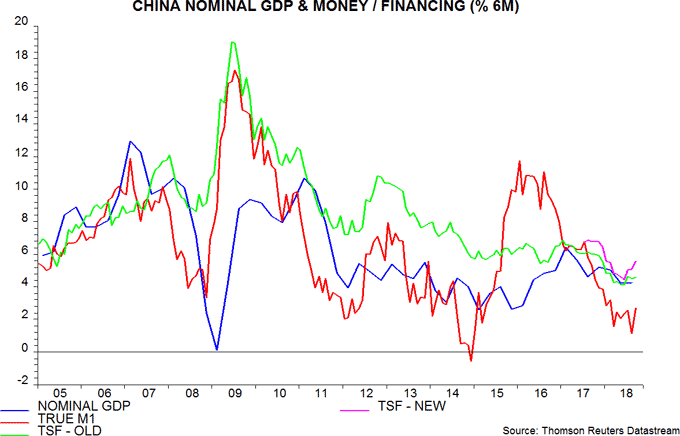Chinese money trends stabilising, outlook still weak
Chinese money and credit trends appear to be starting to respond to policy easing but a further recovery is needed to warrant shifting away from a negative view of economic prospects.
GDP and other activity data released last week confirm that the economy continued to lose momentum during the third quarter. Six-month growth of narrow money*, however, rebounded last month, reaching its highest level since February – see first chart.

Total social financing (TSF) also accelerated, reflecting heavy issuance of local government special bonds, used to finance investment – such bonds were added to the TSF definition this month, with data backdated to January 2017. TSF growth on the former definition remained soft in September, probably partly reflecting local government issuance “crowding out” other financing – first chart.
The apparent bottoming out of money / credit growth suggests a future stabilisation of economic momentum but there is no signal yet of a meaningful rebound. Even if money trends continue to improve, economic growth is unlikely to revive before the second quarter of 2019 at the earliest.
Experience in 2015-16 is cautionary: six-month growth of narrow money was at a similar level in April 2015 and subsequently surged into double-digits (not annualised) but a significant pick-up in two-quarter nominal GDP expansion was delayed until the second quarter of 2016 – first chart.
Increased local government issuance / spending has contributed to a recovery in public sector fixed asset investment, the annual change of which turned positive in September – second chart. Further strength, however, could be offset by a slowdown in housing investment: housing floor space sold was down last month from a year ago, while starts lost momentum – third chart.


Recent and prospective increases in US import tariffs are an additional headwind, while the extent of a rebound in money growth remains unclear, with the authorities still reluctant to sanction full reopening of the credit taps. Such action, moreover, could result in a further increase in capital outflows, dampening the monetary impact and adding to downward pressure on the currency. The forward discount on the offshore yuan suggests that outflows have remained elevated so far in October – fourth chart.

An optimistic view is that significant income tax cuts implemented this month and further reliefs announced over the weekend to take effect in January 2019 will boost consumer spending growth; an acceleration of household demand deposits from October would lend support to this scenario.
Other leading indicators suggest near-term further economic weakness. A composite leading indicator proposed in a previous post as an alternative to the OECD’s measure continued to fall in September, signalling below-trend economic expansion – fifth chart.

*True M1 = official M1 plus household demand deposits. Official M1 = currency in circulation plus corporate demand deposits.

Reader Comments